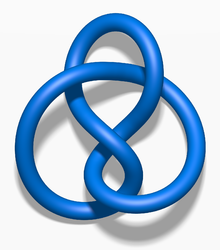Figure eight complement
In the mathematical sub-area of topology , the eighth knot complement is the complement of the eighth knot in the 3-dimensional sphere . It is the simplest hyperbolic 3-manifold and therefore an example discussed in numerous textbooks .
Fundamental group
The Wirtinger presentation of the node group belonging to the node diagram shown on the right is
- ,
where and are meridians around two of the arcs of the knot diagram.
The hyperbolic structure on the Achterknotenkomplement is determined by the discrete , faithful representation defines what to and on maps.
This representation was found by Riley in 1974. Your picture is in the Bianchi group and has a finite index there .
Except for complex conjugation and conjugation with matrices , this is the only hyperbolic structure, see Mostow rigidity .
The Achterknotenkomplement is the only hyperbolic manifold for equality in the Jørgensen inequality is true, which therefore of 2 elements with is generated.
Ideal triangulation
The figure eight complement is obtained by gluing two ideal tetrahedra together .
If the corners of the tetrahedron already glued along the common side surface, then the side surface is glued with , with and with .
The union of the two ideal tetrahedra with corners glued along the common side surface can be used as the fundamental domain of the effect of in the half-space model of the hyperbolic space
to take. (Here the edge at infinity of the 3-dimensional hyperbolic space was identified.)
The adhesive images are then of the matrices
realized with .
Arithmetic invariants
The figure eight complement is the only arithmetic hyperbolic node complement.
Its track body is and its quaternion algebra is .
Hyperbolic volume
The hyperbolic volume of the figure eight complement is
- .
Here is the Bloch-Wigner dilogarithm and .
This is because the ideal tetrahedra in the triangulation above are both regular tetrahedra and thus all dihedral angles . The volume of the ideal tetrahedron with dihedral angles can be calculated using the Lobachevsky function as and for results from this .
Cao and Meyerhoff proved in 2001 that the figure eight complement is the hyperbolic complement of the smallest volume.
Figure eight complement as mapping torus
The figure eight complement is the image torus of Arnold's cat image of the single-dotted torus .
The fundamental group of the fiber is the free group . So you have an exact sequence
- ,
the monodromy is the product of the stretching twists and the longitude and meridian of the torus.
Associated with an image torus of a self-image of a dotted torus one has a canonical ideal triangulation and in the case of monodromy this yields the ideal triangulation of the figure eight complement described above.
Sister manifold
The sister manifold of the figure eight complement is the 3 manifold that is obtained by - stretching surgery on the Whitehead tangle . Like the eighth knot complement, it can be composed of two ideal tetrahedras and, together with the eighth knot complement, is the non-compact, orientable, hyperbolic 3-manifold of the smallest volume.
literature
- WP Thurston: The Geometry and Topology of Three-Manifolds. Lecture Notes, Princeton University 1976–79 online
- Colin MacLachlan, Alan Reid: The arithmetic of hyperbolic 3-manifolds. Graduate Texts in Mathematics, 219. Springer-Verlag, New York 2003, ISBN 0-387-98386-4
Web links
Individual evidence
- ^ Robert Riley: A personal account of the discovery of hyperbolic structures on some knot complements
- ↑ MacLachlan-Reid, op.cit., Section 4.4.2
- ^ Alan Reid: Arithmeticity of knot complements. J. London Math. Soc. (2) 43 (1991) no. 1, 171-184.
- ↑ Chun Cao, Robert Meyerhoff: The orientable cusped hyperbolic 3-manifolds of minimum volume. Invent. Math. 146 (2001), no. 3, 451-478.
- ^ William Floyd, Allen Hatcher: Incompressible surfaces in punctured-torus bundles. Topology Appl. 1982, 13, no. 3, 263-282.
- ↑ François Guéritaud: On canonical triangulation of once-punctured torus bundles and two-bridge link complements. With an appendix by David Futer. Geom. Topol. 10: 1239-1284 (2006).

![\ Gamma = \ langle a, b | \ left [a ^ {{- 1}}, b \ right] a = b \ left [a ^ {{- 1}}, b \ right] \ rangle](https://wikimedia.org/api/rest_v1/media/math/render/svg/aa9846158314230de8310a192d672d64a883fdc6)








![{\ displaystyle \ vert Sp (f) ^ {2} -4 \ vert + \ vert Sp (\ left [f, g \ right]) - 2 \ vert = 1}](https://wikimedia.org/api/rest_v1/media/math/render/svg/d7a4de83ac4ca86348727b289847640269a7c2c8)





























